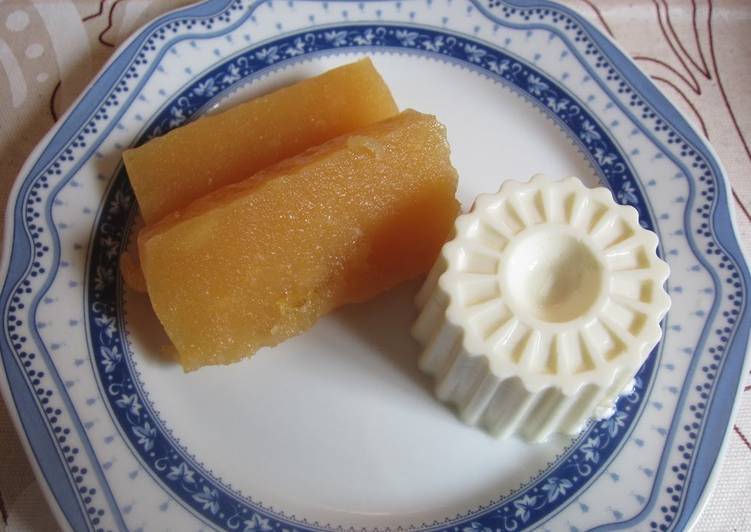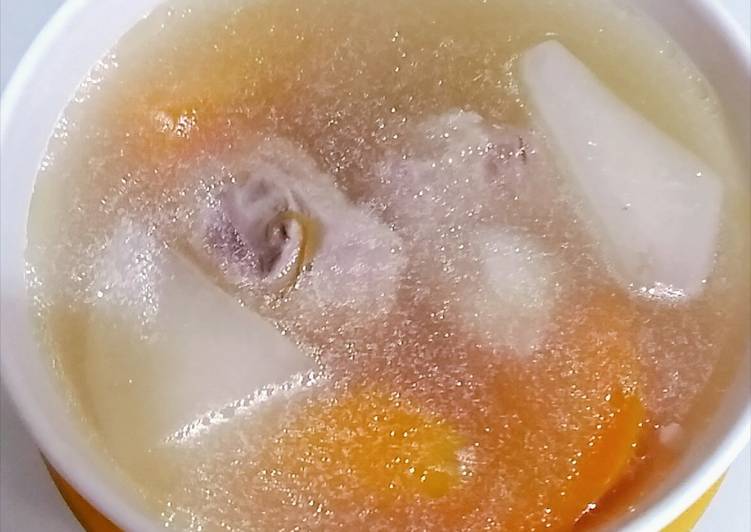
Hey everyone, hope you’re having an amazing day today. Today, we’re going to prepare a special dish, quince jelly (carne de membrillo). It is one of my favorites. This time, I am going to make it a bit tasty. This is gonna smell and look delicious.
Great recipe for Quince Jelly (Carne de Membrillo). I make this quince simmered in sugar every year in the fall. Homemade carne de membrillo is far superior to the store-bought type.
Quince Jelly (Carne de Membrillo) is one of the most well liked of current trending meals in the world. It is appreciated by millions daily. It’s simple, it’s quick, it tastes delicious. They’re nice and they look wonderful. Quince Jelly (Carne de Membrillo) is something which I’ve loved my whole life.
To begin with this recipe, we must first prepare a few ingredients. You can have quince jelly (carne de membrillo) using 3 ingredients and 22 steps. Here is how you can achieve it.
The ingredients needed to make Quince Jelly (Carne de Membrillo):
- Prepare 3 kg, weighed after peeling and removing the stem ends Quince (or "membrillo" in Spanish)
- Make ready 1 1/5 kg Sugar
- Get 2 Lemon (optional)
Membrillo is a jelly/paste made from quince, a medieval Mediterranean fruit that is the European predecessor of the apple. The resulting jelly is a natural companion to a well-cured Manchego cheese and any strongly flavored cheese, especially an aged Crottin or Garrotxa.. Dulce de Membrillo recipe, a popular Spanish paste made from quince and served with Manchego cheese. Photography Credit: Elise Bauer Ever since I started making quince jelly people have been telling me about membrillo, a quince paste that is practically the national snack of Spain when paired with Manchego , sheep's milk cheese.
Instructions to make Quince Jelly (Carne de Membrillo):
- Preparing the quince is rather hard work. So, I recommend making no more than about 3 kg of fruit at a time. That should be about 5 kg before peeling.
- Wash the quince well. Rub the fine downy fuzz off of the surface.
- To prepare the quince: Put the quince and water in a large pot. Bring to a boil and cook the quince until they are tender.
- Note: It's best to immerse the quince completely in water. I had too many fruit in the photo, so I boiled them with the lid on, and shifted the fruit on top around to cook them through.
- Take the fruit out of the hot water and let them cool down. Peel them and remove the stem ends. Roughly chop up the fruit and place them in another pot or in a storage container.
- (You don't have to peel the quince in advance. If you boil the quince until they are falling apart, then the skin and the outer part of the flesh can be removed together.)
- When the fruit has been processed, weigh it out. Calculate 40% of that weight and that will be the amount of sugar to use. (You can increase or decrease the amount to taste.)
- Mash the fruit using a hand-held blender or similar device. Put the mashed fruit in a pot.
- Note: If there's a lot of fruit, it can be difficult to work with, so I recommend mashing it up in the pot first. If you can mash it about 80% of the way, by the time it simmers and reduces it should have just the right consistency.
- Add the lemon juice and sugar to the pot, and start cooking over low-medium heat. Simmer and reduce slowly while mixing. Be careful not to burn yourself.
- You may get burned if the contents of the pot splatter, so don't leave the pot unattended for too long. Stir while simmering and reduce it over low-medium heat.
- Note: If you see any impurities while you're simmering the pulp, remove them with a spoon.
- While you're simmering the pulp, spread a sheet of parchment paper on a flat container (such as an oven baking tray), lining it right up to the edges.
- When the pulp turns orange, remove from heat. Pour the pulp into the prepared tray. Be careful not to burn yourself.
- I cooked 3.5 kg of fruit (after peeling) for a bit more than 2 hours. As shown in the Step 11 photo, the volume has reduced by about 10%.
- Note: This version doesn't have a lot of sugar, so it won't turn brown like commercially sold quince jelly.
- Dry the jelly in a cool location out of direct sunlight. (If you use 40% sugar, this takes 5 days to a week.)
- Slice into pieces. Wrap each piece in plastic. Freeze to store for a long period. Refrigerate any pieces you're going to eat it right away.
- Note: The top surface should be firm and the bottom surface still soft right after you finish drying. If you wrap the pieces up and store them with the firm side down, the texture will gradually even out.
- Note: Of course, you can flip them over, peel off the paper and dry the other side too. You can dry the fruit even further to turn it into a moist dried-fruit type dessert.
- Note: The step-by-step photos show 3.5 kg worth of fruit pulp. I had 7 kg of fruit pulp in the Step 1 photo, so that may give you an idea of the total weight.
- Slice thinly and serve with fresh (un-aged) cheese or on bread. You can also serve it on its own, of course.
Membrillo is a jelly/paste made from quince, a medieval Mediterranean fruit that is the European predecessor of the apple. Or do as the Elisabethans and Jacobeans did and make a jelly to be be eaten with meats, along with a quince cheese, the English name for pâte de coing or membrillo as it is called in Spain. Both can be made at the same time, the jelly is made with the water that the quince has simmered in and the pâte is made from the strained fruit. Dulce de membrillo (or just membrillo) is a sweet, sticky, very thick jelly made from the fruit of the quince tree, and is a typical dessert eaten in Spain, although it is also served with toast at the breakfast table. Unlike the jellies we are used to eating in the U.
So that is going to wrap this up with this exceptional food quince jelly (carne de membrillo) recipe. Thanks so much for your time. I’m sure you can make this at home. There’s gonna be more interesting food in home recipes coming up. Don’t forget to bookmark this page in your browser, and share it to your loved ones, friends and colleague. Thanks again for reading. Go on get cooking!
![How to Make Any-night-of-the-week [Farmhouse Recipe] Tangerine Jam](https://img-global.cpcdn.com/recipes/5708582503841792/751x532cq70/farmhouse-recipe-tangerine-jam-recipe-main-photo.jpg)

